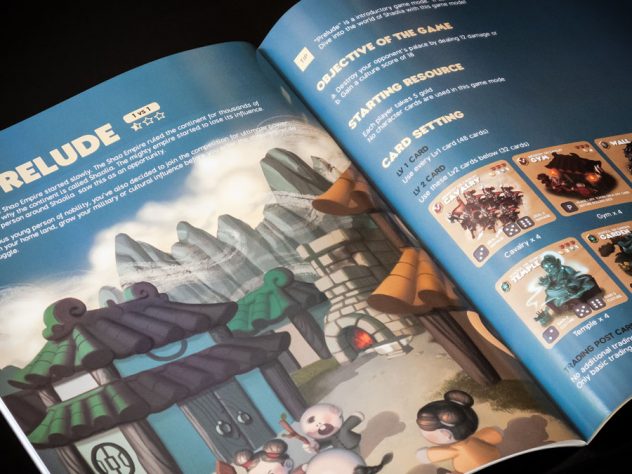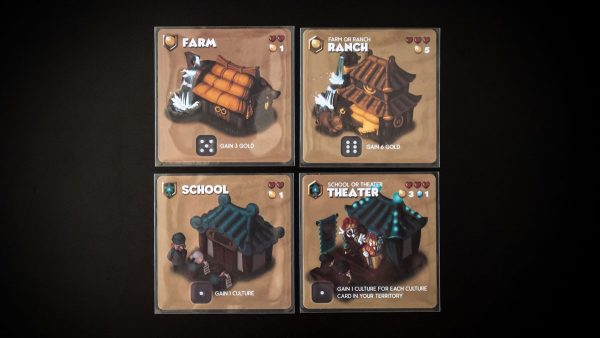On the continent of Shaolia, war has broken out in the kingdom and your lands are in the thick of it. Will your little territory prevail with military might, be the master of trade and commerce, or pursue arts and culture to claim rule of Shaolia? The choice is yours!

What Is Shaolia: Warring States?
Shaolia: Warring States is a competitive card and dice strategy game for 2 or 4 players (as 1 vs 1, or 2 vs 2), for ages 14 and up, and takes about 30-60 minutes to play. It is designed by Gunho Kim with art direction by Sophia Kang and produced by Bad Comet Games. Shaolia just launched on Kickstarter today, with a pledge level of $39 (plus shipping) to receive a copy of the finished game.
New to Kickstarter? Check out our crowdfunding primer, and visit our Kickstarter curated page for more projects we love.
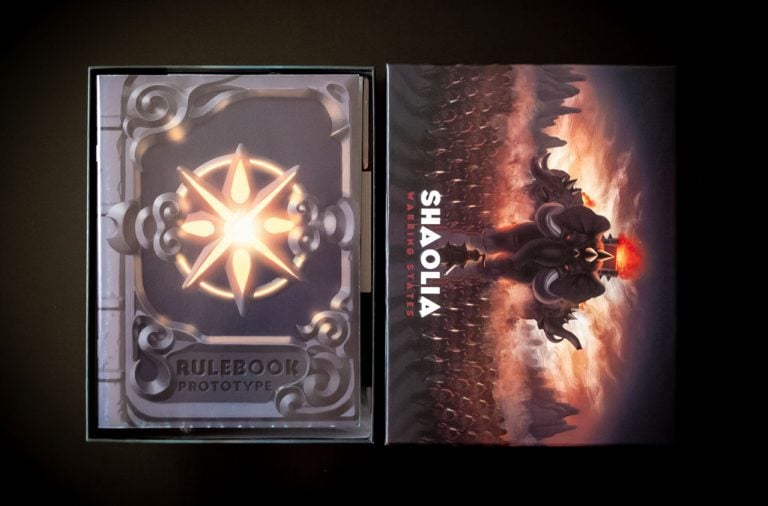 Unboxing the prototype. (Prototype shown) Photo: Erik Stanfill
Unboxing the prototype. (Prototype shown) Photo: Erik Stanfill
Shaolia Components
When I received the prototype of Shaolia for review, I was impressed with the art and component quality. I had to double check to make sure this was a prototype and not a mass pre-production copy!
The game was practically finished with shrink-wrapped printed cards, custom wooden tokens, and printed token punchboards. This attention to the prototype says a lot about Bad Comet’s commitment to the game. However, I will give a standard disclaimer that my review is based on a prototype, so it is subject to change and may not reflect final component quality.
4 Territory boards
1 Trading board
48 Level 1 (Lv1) cards
70 Level 2 (Lv2) cards
10 Character cards
8 Locked space cards
9 Trading postcards
57 Gold tokens (in values of 1 and 5)
20 Attack tokens
20 Life tokens
10 Blockage tokens
20 Minerals
25 Officers
4 Cultural score trackers
40 Damage counters
10 Dice
1 First player marker
4 Player aids
1 Rulebook
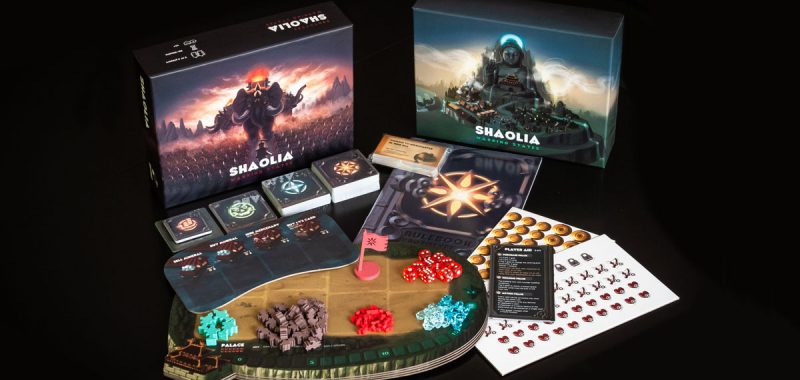 Shaolia components. (Prototype shown) Photo: Erik Stanfill
Shaolia components. (Prototype shown) Photo: Erik Stanfill
How to Play Shaolia: Warring States
You can download a copy of the prototype rulebook here. Shaolia is also available for Tabletop Simulator
and there is even a print and play (PnP) version available to try the game out.
The Goal
The basic goal of Shaolia is to defeat your opponent by gathering resources, constructing buildings, and creating military forces to either score 18 points on your culture track or deal 12 points of damage to your opponent’s palace.
Setup
The first step is to decide which game mode to play. I’ll talk more about game modes below but, to sum up, they determine which Lv1 cards, Lv2 cards, character cards, and trading post cards will be used in the game. There may be an additional victory condition, too.
Each player takes a territory board and places in front of them. Each territory board gets two “locked” space cards: one to the leftmost top row space, and one to the rightmost bottom row space. During gameplay, players may pay to remove these cards and free up additional space on their territory boards. Place a lantern score tracker on the culture track space marked “0.” Set up the trading board according to the chosen game mode.
Each player will also receive three dice, five gold tokens, and any other starting resources and character cards, again, as instructed by the game mode. Shuffle the Lv1 cards and place them on the table, leaving room for a discard pile. The Lv2 cards used by the game mode will also be shuffled and placed next to the Lv1 cards, however, draw and place three cards face up in a row.
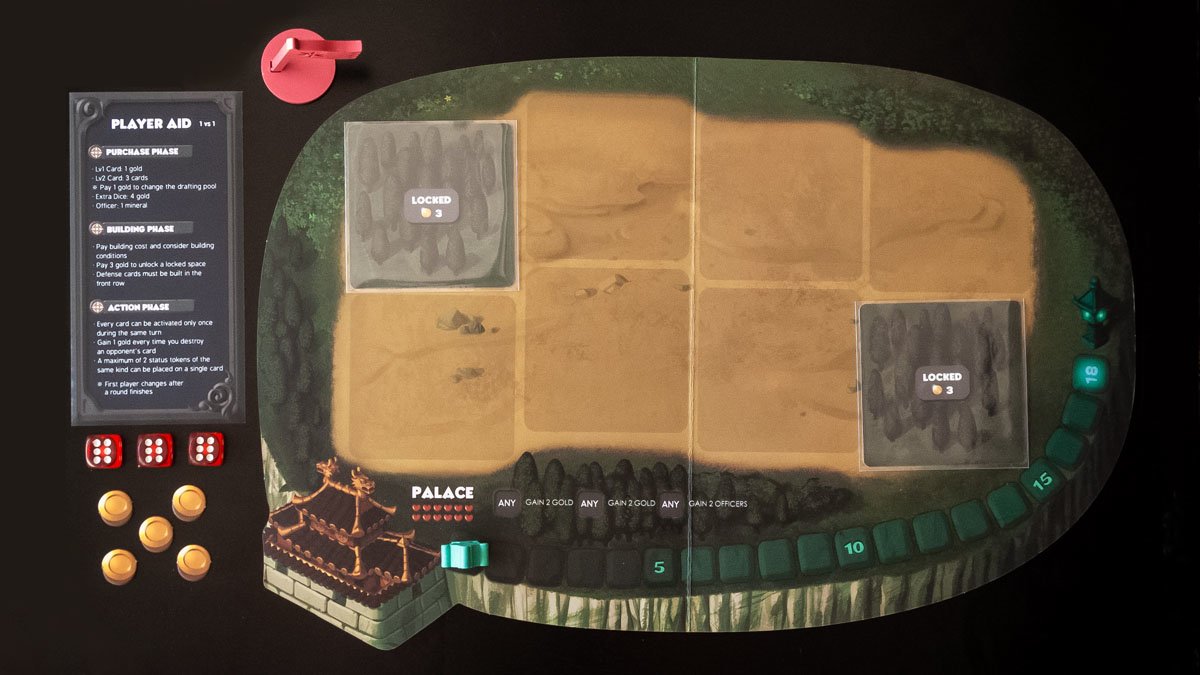
Game Modes
There are five different game modes in the prototype rulebook, four for 1 vs. 1 play and one for 2 vs. 2 team play. I’m not going to go over every single one, but the rule book suggests beginning with “#1 Prelude” and I agree that is a good place to start. We discovered that each subsequent game mode introduces different groups of cards, trade options, and starting resources so you are not overwhelmed with all the content at once. There are even suggestions on how to make your own game modes.
“#1 Prelude” game mode in rulebook. (Prototype shown) Photo: Erik Stanfill
Gameplay
Each round of play consists of three phases. Starting with the player with the first player marker, each player will take their turn during a phase before moving on to the next phase. At the end of the round, the first player marker will pass to the next player.
In the purchase phase, players will be buying cards and resources to prepare for building. Four things are available for purchase: Lv1 cards, Lvl 2 cards, extra dice, and officers. A Lv1 card costs one gold and is drawn from the stack. To purchase a Lv2 card, trade in any three cards from your hand, then pick from the three available, refilling after selecting a card. You may also purchase two officer tokens for one mineral. You may also buy extra dice at four gold per die.
There isn’t any limit on the amount of stuff you can purchase; you can even combo them up. For example, you may buy 3 Lv1 cards, then immediately trade them in for a Lv2 card. All cards, except for character cards, are open information, so purchased cards are placed next to the player’s territory board face-up. Also, if none of the Lvl2 cards available are appealing, a player may spend one gold to clear the row and place three new cards.
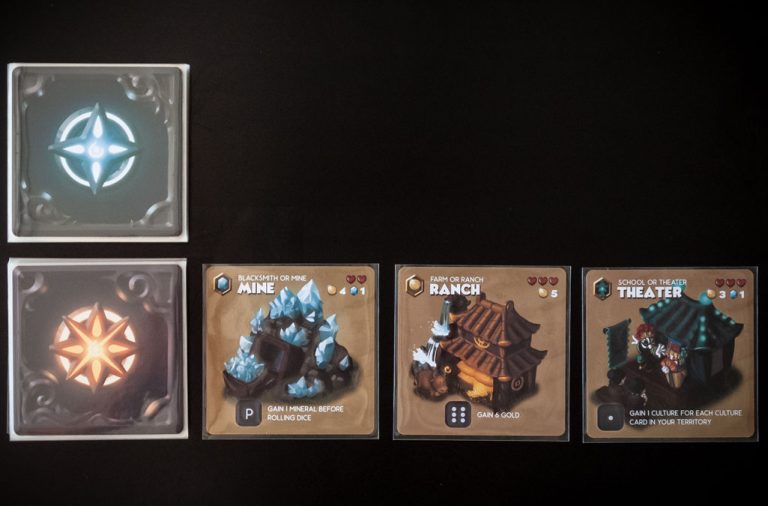 Lv1 cards (top) and Lv2 cards (bottom) setup. (Prototype shown) Photo: Erik Stanfill
Lv1 cards (top) and Lv2 cards (bottom) setup. (Prototype shown) Photo: Erik Stanfill
After the last player is done purchasing, the building phase occurs, where players may build purchased cards on their own territory boards. The cost to build a card is listed on the upper right corner below the hearts, usually a combination of gold and minerals. Lv1 cards have basic abilities like “Gain 3 gold,” while Lvl2 cards are more powerful, with abilities like “Gain 6 gold”. In order to build a Lv2 card, you need to have built a specific Lv1 card or Lv2 card beforehand as listed as well as the cost.
Examples of Lv1 cards (left) and Lv2 cards (right). (Prototype shown) Photo: Erik Stanfill
On the top left of each card is an icon that clues you in on what that card can do or what resource it can procure. A gold coin means the card will get you gold, a mineral will get you minerals, swords are attack cards, and so forth. This is handy so you don’t have to read the entire card to see if you want it.
The location of cards on the territory board can be important, too, as some cards can only be placed in the top row, and some have abilities that trigger from whatever is adjacent to them. Once cards are built, they cannot be moved, but they can be demolished and put in the appropriate discard pile. And, as stated before, players may remove a “locked” territory card by paying 3 gold.
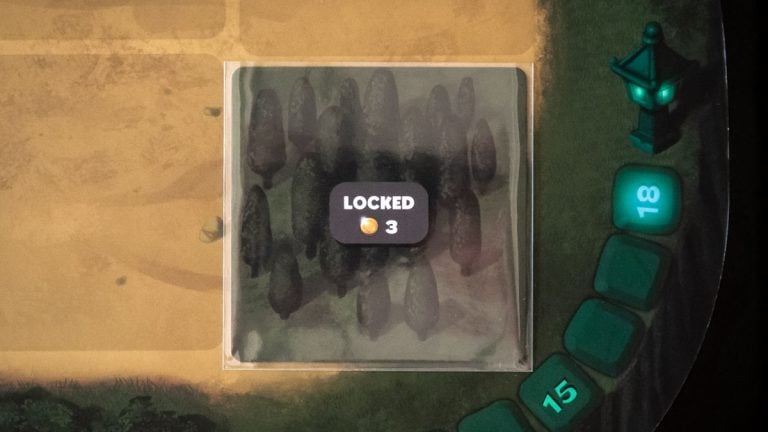 Territory locked card. (Prototype shown) Photo: Erik Stanfill
Territory locked card. (Prototype shown) Photo: Erik Stanfill
Once players are finished building, we are ready for the action phase, where we put all the planning to the test. In turn order, players roll their dice and assign them to card abilities based on the die value. Players may spend an officer token to adjust a die value up or down one.
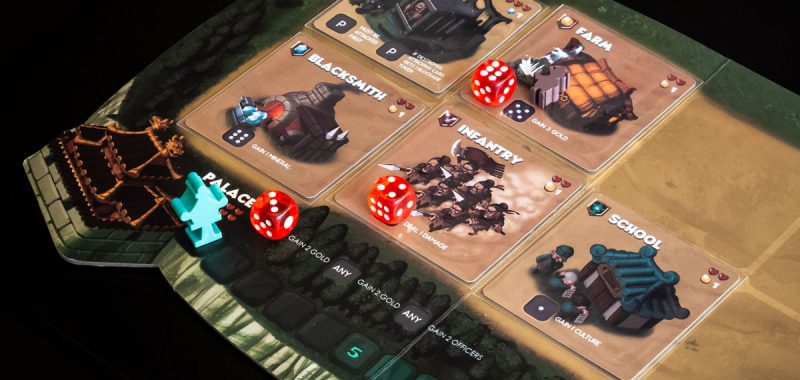 Die placement example. The 3 is placed on the Palace to get 2 gold. The 4 is placed on the Infantry to deal one damage. The 6 is changed to a 5 with an officer token and placed on the Farm to get 3 gold. (Prototype shown) Photo: Erik Stanfill
Die placement example. The 3 is placed on the Palace to get 2 gold. The 4 is placed on the Infantry to deal one damage. The 6 is changed to a 5 with an officer token and placed on the Farm to get 3 gold. (Prototype shown) Photo: Erik Stanfill
Most cards have an activated ability that is triggered when a die is placed on them. Some (like defense cards) have passive abilities; they are always “on” and don’t require activation. Some Lv2 cards have two abilities listed: a simple one and a more powerful one that requires two dice. You may activate one or the other, but not both. Like the purchasing phase, you can combo and use resources immediately after you obtain them.
The palace has three basic abilities (2 gold, 2 officers) that dice may be assigned to regardless of value, so you always have dice placement options even if you can’t activate cards.
Attacking & Player Interaction
Any Lv1 or Lv2 cards with the swords icon can deal damage to your opponent’s buildings, units, or palace. Once a card takes damage equal or greater than the amount of hearts listed in the top left corner, the card is destroyed and put into its respective discard pile. The attacker also receives 1 gold for each destroyed card. As a side note, we agreed that the tiny broken hearts are the most adorable damage markers ever. Some cards and trade options will get you attack tokens to buff up your attacks and blockage tokens to lock an opponent’s card; they will have to activate the card to remove the lock and gain back its ability for future turns.
 Broken heart damage markers. (Prototype shown) Photo: Erik Stanfill
Broken heart damage markers. (Prototype shown) Photo: Erik Stanfill
Trading
The trade board has four basic trades preprinted on the top and four empty slots on the bottom for trade cards. Each game mode lists specific cards to use. Trading is triggered by building abilities and usually involves purchasing a resource or one-time ability or trading resources for others.
 The trade board. (Prototype shown) Photo: Erik Stanfill
The trade board. (Prototype shown) Photo: Erik Stanfill
Characters
Certain game modes will also introduce character cards, which are either handy one-time effects or built for their unique abilities. These cards are the only component that is hidden information in the game. There’s an option to discard them anytime for four gold.
After a player has assigned all their dice and performed their actions, then the next players roll their dice and complete their actions. Then, when the last player is finished, the first player marker is passed and a new round begins.
Game End
The game ends immediately when a player wins by earning 18 points on the culture track or manages to destroy their opponent’s palace by dealing 12 damage to it. However, certain game modes may have an additional victory condition.
Shaolia with 4 players
Playing Shaolia with 4 players is like 1 versus 1; it’s a team-based “two-headed giant” version of the game instead of a 4-player free-for-all. Partners will be working together to destroy one of their opponent’s palaces or achieve a collective 18 culture points. During the purchase phase, partners may trade resources for free, or cards after paying 1 gold.
 First player marker and other components. (Prototype shown) Photo: Erik Stanfill
First player marker and other components. (Prototype shown) Photo: Erik Stanfill
Why You Should Play Shaolia: Warring States
Even though Shaolia is a relatively fast-paced strategy game, there is depth to it. Having player turns go back and forth during the three phases moves the game at a good pace; almost all our games finished under 45 minutes. There is always something you can do, but that means there are a lot of choices. This is a game that will reward replay and trying out new strategies.
I found that you really need to do as much building as you can up front, demolish as necessary, and plan ahead with Lv2 purchases. Paying attention to what your opponent is doing is key. Often, I would be lost in my own world of building, just to see that my spouse could win next turn by pulling off a massive culture point combo. I missed her picking up all those School and Temple cards. Refreshing the Lv2 trade row can be a great tactic here and provide delicious frustration for your opponent!
In our first games, we didn’t use the trade board as much as we thought we would, and I’d expect that would be a common experience for others. It was about getting to know the cards at first, Then in later games, we started to use the trade board more. This is why I liked going through the game modes as they introduced different card sets and trade options. Once we have thoroughly played all the game modes, I’d imagine that we would just play with everything for the full Shaolia experience.
Randomness does come into play with buying Lv1 cards and dice rolls. However, getting officers to help mitigate bad rolls is easy; I made sure I always had a few on hand. Unused Lv1 cards still have their trade value, of course. Ultimately, I never felt that luck was a huge swingy factor in our games; if I lost, it was because of my choices, not my dice rolls.
After several games in, we noticed that winning with the culture track happened all the time; it seemed really difficult to pull off a military victory. After hearing from other reviewers and playtesters, we learned we were not the only ones experiencing this. The issue has been recognized by the designer and he has stated that additional tweaking will be done to give a better balance between the strategies. Bad Comet has been open and responsive to all feedback and communication, so I’m confident that the production version will have a good balance.
And finally, I have to praise the fun art direction and components; it is well thought out and produced. I love the art of the little dragon boats filled with stacks of tokens for trade. The wooden first player flag is a nice touch, and I want more of the little broken heart damage markers for all of my games. I hope a lot of the design decisions remain in the final production.
I highly recommend Shaolia: Warring States. We had a lot of fun playing. It’s an engaging experience, fast-paced, with fun gameplay and amazing art. I feel a lot of people, especially fans of strategic 2-player games, will really enjoy this game.
For more information or to make a pledge, visit the Shaolia: Warring States’ Kickstarter page!
Click here to see all our tabletop game reviews.
To subscribe to GeekDad’s tabletop gaming coverage, please copy this link and add it to your RSS reader.
Disclosure: This post was sponsored by Bad Comet Games.

